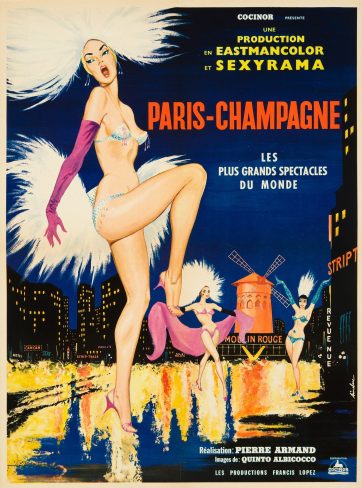 Undoubtedly the most inventive and unorthodox film to emerge from the 1960s Mondo movie cycle. As with quite a few such films, PARIS CHAMPAGNE (1962) was made to showcase—or better yet, exploit—the particulars of European nightlife, in this case Parisian burlesque clubs, but writer-director Pierre Armand imparts a creative exuberance that belays his film’s tawdry origins.
Undoubtedly the most inventive and unorthodox film to emerge from the 1960s Mondo movie cycle. As with quite a few such films, PARIS CHAMPAGNE (1962) was made to showcase—or better yet, exploit—the particulars of European nightlife, in this case Parisian burlesque clubs, but writer-director Pierre Armand imparts a creative exuberance that belays his film’s tawdry origins.
One element of PARIS CHAMPAGNE you won’t find in too many other Mondos is the fact that it has a story (of sorts) and characters to bolster the traditional Mondo travelogue format. Those characters include a young woman florist and a bum, who meet one day on the banks of the Seine, where the bum impresses the gal by transforming her flower cart into a snazzy sports car and himself into a dashing young man.
From there the guy and gal, accompanied by a high-spirited, jazzy score by Francis Lopez and Armand Migiani, embark on a tour of several of Paris’ most famous cabarets, including the Moulin Rouge and the Lido, where they—and we—witness a number of elaborate burlesque routines performed by lovely ladies in various states of undress. Also afoot is the Devil, a frequently shirtless red-skinned creep who mans a self-driving red convertible and masquerades as a waiter.
After about a half hour the couple head to the countryside. There things grow increasingly surreal, with talking animals making their presence known, along with assorted musicians, acrobats and strippers, all of whom eagerly perform for the protagonists. The landscape, meanwhile, undergoes a variety of transformations, becoming a parched desert, a western town, a medieval castle and a tropical paradise. But the Devil is still afoot, and makes sure to cause trouble by stealing the clothing of women seen stripping by the lakeside (as the women in this film have a tendency to do) and making time flow in reverse, until the reality behind the strangeness finally becomes clear.
All this is bolstered by an incredibly vibrant color scheme based more on aesthetic whims than on dramatic incident (i.e. a close-up of a red flower that leads to the subsequent sequence being tinted red), something that can be said for the film as a whole. Its aims and budget may be modest, but Pierre Armand evidently worked overtime to create something of real resonance, and has emerged with a film that’s sleazy and exploitive, as intended, but also poetic and authentically dreamlike. It’s not unlike some unholy collaboration between Russ Meyer and Luis Bunuel.
Release-wise PARIS CHAMPAGNE never got much exposure anywhere. Its theatrical release was confined to France and the Netherlands, and it did little business in either country (due most likely to fact that it was around 5-6 years ahead of its time—I believe late sixties audiences would have appreciated its tripped-out aesthetic far more than those of the early part of the decade). Curiously enough, though, the film’s poster art has become quite iconic. The dancing showgirl imagery that poster presents is quite striking, yes, but I say the film it advertises is equally worthy.
Vital Statistics
PARIS CHAMPAGNE
Les Productions Francis Lopez
Director: Pierre Armand
Producer: Francis Lopez
Screenplay: Pierre Armand
Cinematography: Quinto Albicocco
Editing: Georges Arnstam
Cast: Jean Lefebvre, Marjorie Lemoing, Philippe Gaste, Raymond Pierson, Maria Candido, Daniel Delbrouck, Stephan Mucsi, Poupee La Rose, Biquet Marina, Nathalie Cha, Lolo Pigalle
